High-yielding cold-tolerant hybrid of Tobia f1 cabbage
Tobia f1 is a hybrid of white cabbage. Included in the state register of the Russian Federation in 2007 and zoned for cultivation in the Middle Volga, North-West, Central, Volgo-Vyatka, West Siberian, Ural, East Siberian districts. Vegetable growers have already appreciated the Tobia f1 cabbage for its large size, high yield, taste and marketability. The vegetable is adapted to any climatic conditions; neither cold nor heat affects its productivity.
The content of the article
Description of cabbage hybrid Tobia f1
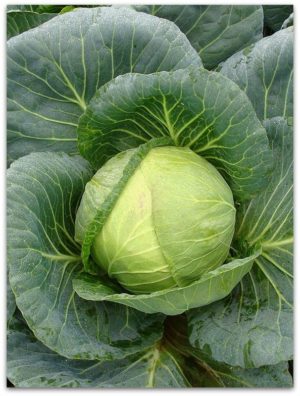
The hybrid was developed by Dutch breeders. Experimental samples showed fast germination of seeds, early maturity, excellent keeping characteristics. The purpose of the creation of Tobia f1 was to provide private vegetable growers and farms with cabbage, which can be harvested both manually and mechanically.
Tobia belongs to the early maturing hybrids. The stump is small, so the plant itself grows short. Thanks to this, the leaves receive accelerated nutrition and nutrients that contribute to the early formation and maturation of the head of cabbage. They are round-flat in shape and differ in density. Inside, the head of cabbage is white, its average weight is 5-7 kg. The vegetable reaches technical maturity in 90 days from the moment of germination.
The upper leaves are dark green in color with light veins, clearly visible, but not too hard. The surface has a waxy coating. The structure of the leaves is dense, slightly pimply, the edges are wavy. During ripening, they curl into a dense head of cabbage.
Disease resistance
Tobia has strong immunity and resistance to many cabbage diseases, including:
- powdery mildew;
- fusarium;
- blackleg;
- late blight;
- white, gray rot;
- mosaic.
Composition and properties
Its rich chemical composition makes Tobia f1 hybrid cabbage ideal for replenishing and saturating the body with useful nutrients. The vegetable contains the following vitamins, macro- and microelements:
- thiamine (B1);
- pantothenic, ascorbic, nicotinic and folic acids;
- riboflavin;
- biotin (H);
- vitamins K and P;
- potassium;
- sodium;
- magnesium;
- phosphorus;
- sulfur;
- cobalt;
- nickel;
- molybdenum;
- silver;
- tin;
- vanadium.
Tobia cabbage is characterized by an abundance of enzymes. The biochemical composition of the culture makes it one of the indispensable food products and endows it with unique healing properties. The high efficiency of fresh cabbage juice for the healing of wounds, gastric and duodenal ulcers has been established. Sauerkraut reduces the risk of developing cancer, normalizes the nervous system, strengthens bone tissue, and improves skin and eye health.
Read also:
The best Dutch varieties and hybrids of white cabbage
The best varieties of cabbage for pickling and storing for the winter
The main advantages and disadvantages of the Tobia f1 cabbage hybrid

Among the main advantages, vegetable growers note:
- Pleasant sweetish taste without bitterness. Cabbage is tasty and healthy in any form - fresh, boiled, fried, salted, stewed, baked.
- Resistance of heads to cracking. Even in rotted form, during storage and transportation, they maintain their integrity.
- Resistance to low temperatures (down to -10 ° C).Heads of cabbage ripen well in open field conditions.
- Easy care. The cultivation does not require the use of special measures and expensive fertilizers.
- Good texture density and richness.
- High yield rates. With optimal care from 1 sq. m you can collect more than 20 kg of cabbage. On an industrial scale, up to 100 tons are obtained from 1 hectare.
- Versatility in cooking. Due to thin leaves and the absence of thick veins, the vegetable has a delicate texture and pleasant taste. It takes a minimum amount of time to prepare it.
Disadvantages of a hybrid:
- low shelf life (3 months);
- close location of outer leaves to the soil surface (increases the risk of rot development).
Features of planting and growing
To obtain a high and high-quality harvest, it is required to carry out agrotechnical work correctly. It is best to grow cabbage in seedlings in order to protect the vegetable crop from severe frosts and leave the maximum number of sprouts for ripening.
Planting dates for seedlings vary from 1 to 10 April. This is the most optimal time for the sprouts to be fully ready for transplanting into open ground by the end of May. The development of seedlings from seeds takes an average of 45 days. For its cultivation, first of all, it is necessary to properly prepare the soil.
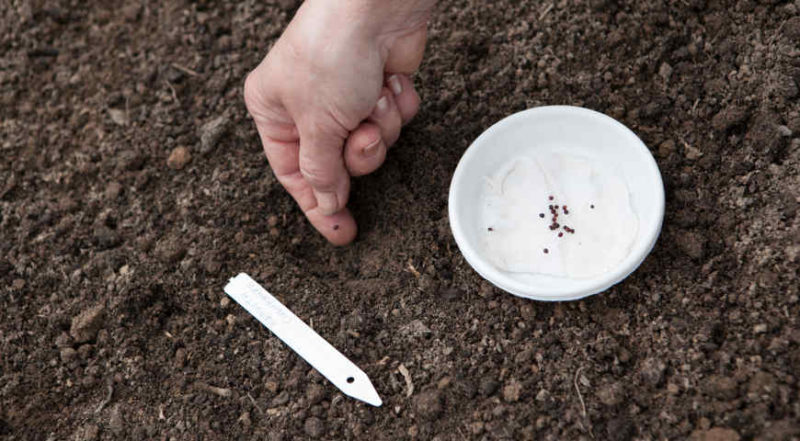
Priming
The best substrate is peat filler, as cabbage loves fertile, loose soil. You can use store mixes, but self-preparation of the soil is preferable for vegetable growers. In addition to peat, compost, sod and humus are added.
Several mix options:
- humus, turf, sand in proportions 50/45/5;
- sand, peat - 50/50;
- compost, sod, peat - 40/30/30;
- peat, turf, sand - 70/25/5.
Before planting seeds, the soil for planting is well warmed up. The best options are to spill it with boiling water or heat it up in the oven at 200 ° C. Then the soil is treated with a strong solution of potassium permanganate for disinfection and left for 14 days for the growth of beneficial bacteria.
Planting material
The next step is seed preparation. To do this, carry out:
- Correct selection. Large specimens are selected from the total number, dried and puny seeds are rejected.
- Hardening. The selected seeds are placed in cheesecloth and immersed in water at a temperature of + 50 ° C. Stand for 20 minutes. Then they are transferred to cold water.
- Disinfection. For 10-15 minutes, the seeds in the bag are placed in a pink solution of potassium permanganate for the prevention of black leg, then washed with running water.
- Stratification. The planting material in gauze is placed in the refrigerator for a day. This time is enough for the appearance of filamentous roots.
Since Tobia f1 belongs to hybrids, it is necessary to buy seeds in specialized stores. Your own planting material or purchased from your hands will not work, it loses the qualities of the mother plant.
Seedling preparation
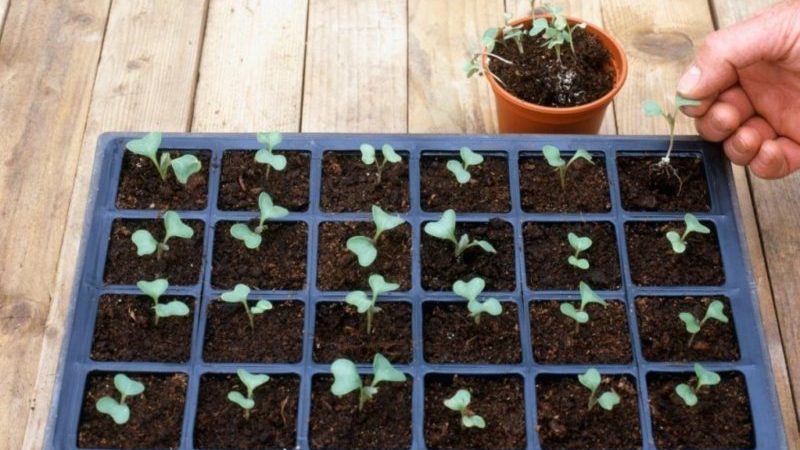
You can sow seeds in separate or general containers. In the latter case, diving is indispensable. Sowing is carried out according to certain rules:
- Place the soil substrate 4-5 cm thick in a container for growing seedlings.
- Spill the soil with a fungicide (for example, "Gamair").
- After 2-3 days, make grooves to a depth of 1 cm every 3 cm from each other and place the seeds at a distance of 1.5 cm.
- Sprinkle about 1 cm of soil over the seeds.
- Leave the container in a room with a temperature of + 18 ... + 20 ° С.
- When the seedlings hatch, it is necessary to create a temperature regime within + 9 ° C.
The pick is made a week or 10 days after the emergence of shoots. To do this, the same soil is placed in plastic cups with the addition of double superphosphate (1 tbsp. L per 10 l of water) and wood ash (2 tbsp. L.). Sprinkle the surface of the soil with river sand to exclude the formation of a black leg. The optimum temperature for the growth of cut seedlings is + 15 ° С.
2.5 weeks before the date of planting in open ground, the sprouts begin to harden, taking them out to fresh air every day.The initial duration of being outdoors is 20 minutes with a subsequent increase in the time. In the same period, urea (1 tbsp) and calcium sulfate (1 tbsp) dissolved in 10 liters of water are added to the soil where the seedlings grow.
Transplanting
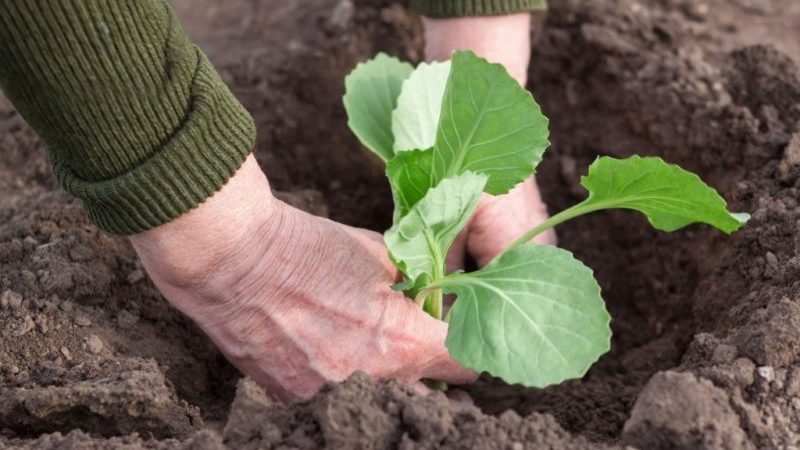
When transplanted into open beds, shoots should have five leaves and a strong stem. For planting, choose a fertile loamy soil with an acid-base balance of no more than 4%. If the indicators are higher, it is recommended to treat the soil with limestone, add humus, compost, wood ash, phosphorus-potassium fertilizers. The area for growing cabbage should be well lit by the sun. In shaded areas, the head of cabbage will not form properly (it will become loose and like a broom).
On a note. It is better to plant the Tobia hybrid in places where onions, tomatoes, carrots, cucumbers, legumes and cereals previously grew. Planting sites must be changed every 4 years, as pests and diseases accumulate in the soil.
Wells for a hybrid are made according to the scheme 40 * 50 cm (in row spacing up to 60 cm). The seedlings are buried to the first leaf in the previously shed soil, which is compacted around the planted sprout.
Seedless landing
You can also plant Tobia cabbage with seeds in open ground. This method is used to reduce workload and save time. It is necessary to plant in a heated and well-moistened loamy substrate. To make it convenient to sow and water, make beds 30-40 cm high and 40 cm wide.
On a note. Seed holes are best formed with the bottom of a glass bottle. So the soil will be slightly compacted and small grains will not be washed away when watering.
Put 3-4 seeds in the resulting holes (it is better to plant with a margin for 100% germination). Then sprinkle with humus, press lightly, cover with a pre-prepared plastic bottle with a cut off bottom and a twisted cork. Cover the container with earth for greater stability.
Care
Hybrid care Tobia f1 is carried out according to the standard agrotechnical scheme.
Watering
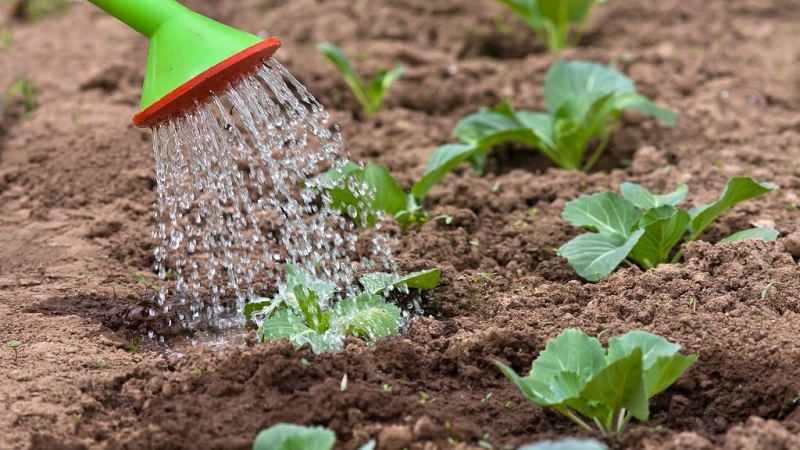
At the beginning and throughout the growth, it is necessary to monitor the soil moisture. Watering should be frequent. At the initial stage of development, 2 liters of water are poured under each bush at a time. As it grows, the amount of water increases to 5 liters. Watering is stopped 20 days before harvesting.
Top dressing
Many gardeners try not to use chemical mineral fertilizers. Infusion of chicken droppings, mullein, watering and dusting with wood ash are a good alternative. Top dressing is carried out two weeks after planting the seedlings, then again after 12 days, when the heads are poured and a month before harvesting.
Council. Watering and feeding is best combined.
Weeding and loosening
During the growth of cabbage, weeds should not be allowed to grow. They are removed at the same time as loosening the soil with a hoe. The depth of processing of the surface layer is 7 cm. For the growth of the root mass, three weeks after planting, hilling is carried out with a hill height of 20 cm.
Pest and disease control
Tobia is highly resistant to rot, fusarium, but can be affected by aphids, cruciferous flea. To combat them, black (red) ground pepper, wood ash, and tobacco dust are scattered under the bushes and on top of the leaves. The pest that you have to deal with manually is the cabbage caterpillar.
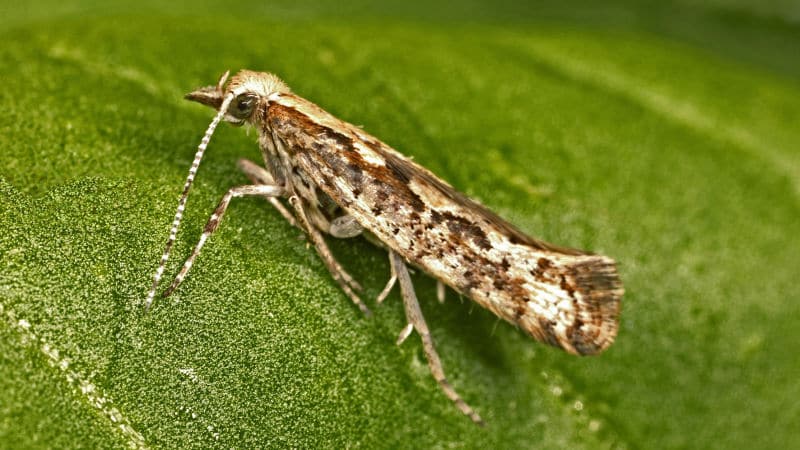
Harvesting and storage
Hybrid cabbage Tobia is frost-resistant, so it is not afraid of frost. But to maintain the ability to keep high, the effect of low temperatures on the vegetable should not be long. Harvesting cabbage from under the snow at -6 ° C and below negatively affects the storage of the crop, as well as repeated frosting after thawing.
Important. If the cabbage has come under severe frost, the cabbage should be thawed without being cut. This usually takes 3-4 days. After that, the cabbage can be cut and sent for the winter.
How to properly cut a vegetable for storage:

- harvesting is done on a sunny warm day;
- dug cabbage with a shovel, clearing roots and stumps from the ground;
- poorly formed heads of cabbage are removed, the upper damaged leaves are cut off, leaving 1-3 integumentary;
- the roots can be cut or left depending on the storage method.
Before storing cabbage, it needs to be dried. To do this, they build a canopy that will protect the crop from precipitation and sunlight, spread the heads of cabbage under it and hold it for 4-5 hours.
Hybrid Tobia f1 is best stored in a dry cellar at -4 ° C. The shelf life with proper collection reaches 6 months.
What can be the difficulties in growing
Vegetable growers do not notice any particular problems when planting and caring for this hybrid. The most important thing is to choose the right place for planting and prepare the soil according to all the rules. The only negative is the inability to collect your seeds.
Reviews and advice of gardeners
Vegetable growers respond positively to the hybrid. Some admire the taste, others are satisfied with the characteristics of frost resistance, and still others plant a vegetable for an early harvest. But all the reviews have one thing in common: the Tobia f1 cabbage is one of the best Dutch hybrids.
Svetlana, Altai Territory: "In our region, the weather is rather unstable. Summer residents have a hard time. Frosts can hit even in June and destroy all plantings. This has happened to me more than once. Sparing my work, I began to choose only frost-resistant vegetables, among which I can single out the Tobia f1 cabbage. I have been planting it for 12 years now and do not want to change it to others. We always have cabbage, which ripens early, is well stored, and the dishes with it are simply a culinary masterpiece. I recommend this wonderful hybrid to everyone. "
Claudia, Yekaterinburg: “I love experimenting with growing vegetables. I plant a lot, since the amount of land allows. Speaking of cabbage, I would like to highlight the Tobia f1 hybrid. I started planting it as an experiment in 2009 and continue to this day. You can say that I have found for myself the perfect hybrid of white cabbage. It is delicious to cook, well stored, and most importantly, it is not afraid of frost, which is not uncommon in our area. I recommend to you too ".
Read also:
Early ripe hybrid of cabbage Krautkayser F1
Nozomi f1 ultra-early ripening cabbage hybrid
Why is Romanesco cabbage useful, what it looks like in the photo, is it difficult to grow it
Conclusion
Tobia f1 is a unique hybrid of hardy and high-yielding white cabbage. The possibility of seedling and non-seedling planting, ease of care, high keeping quality with proper storage made it popular in many regions of Russia. Tobia f1 cabbage is a great option for areas with unstable weather and insufficiently nutritious soil.